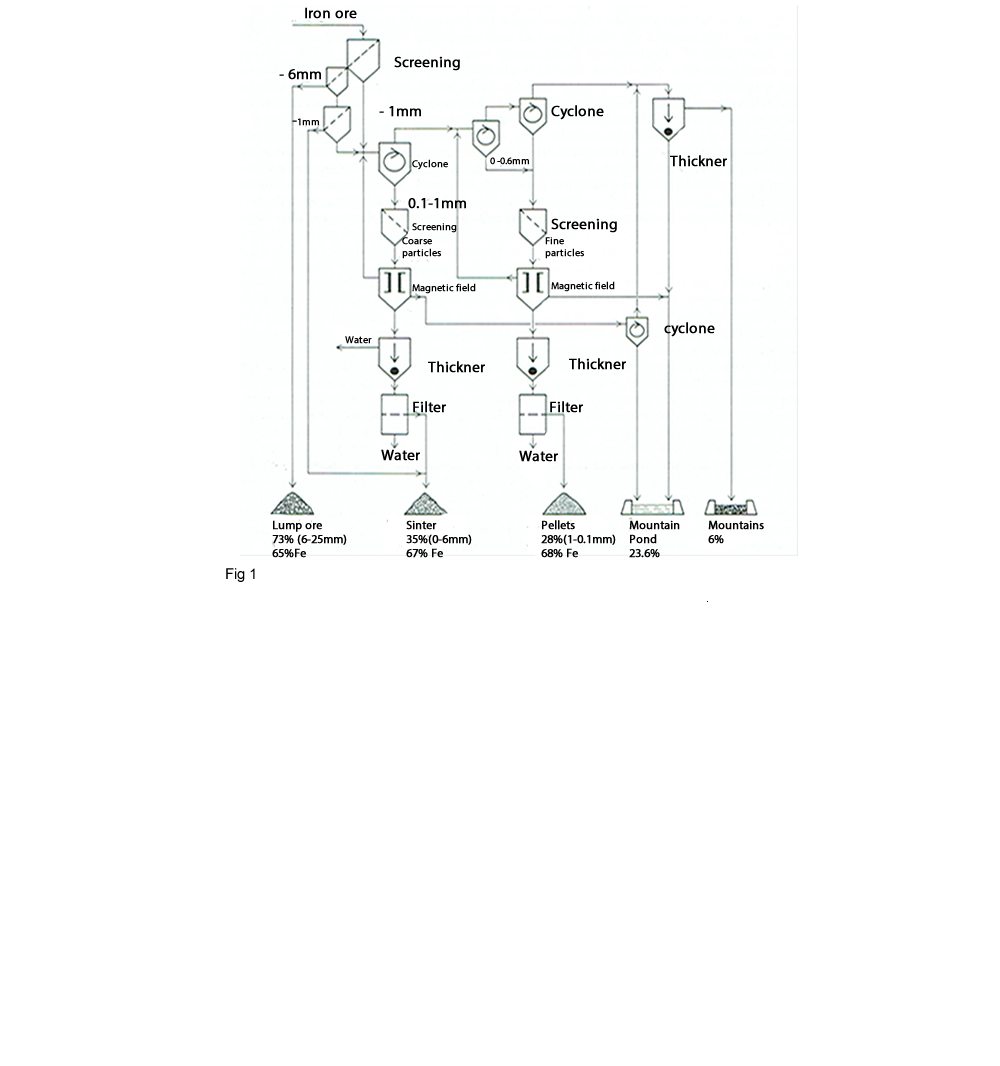Beneficiation of Iron Ore
The purpose of beneficiation is to provide the following advantages:
- less amount of added elements in the ore
- Increase the reduce ability of the ore
- make the ore suitable for transport
The only processing steps used for ores mined from rich deposits (rich ores) are crushing and screening. These ore will be crushed and screened up to particles of about 8 -30 mm. Such ores come mainly from the weathering zones of itabirite deposits. At some mines, washing is combined with the screening of fines (< 6 – 8mm) for sintering process.
The predominant portion of iron ores must be conducted the beneficiation process; very fine material containing alumina content is reduced. In the enrichment process the gangue will be reduced and in many cases; its composition improved. Current reduction and smelting process require a slag with basicity (CaO/SiO2 > 1),but the gangue of nearly every type of iron ore is acidic ,therefore the silica will be reduced through beneficiation process to about 5-8 % .Harmful component in the ore such as P, As, Cr, Cu, V, alkali, sulphur and Ti< 0.5%must be removed.
The basic methods of beneficiation for iron ores are usually the same as for nonferrous ores. Of course some difference can be occurred because of the mineralogy and the type of intergrowth.Beneficiation facilities
Crushing
Primary crushers are used as gyratory or jaw crushers. Cone crushers are common for second and third stages of crushing. They are however, increasingly replace by semiautogenous grinding (SAG).Autogenous mills are tumbling mills of large diameter and relatively short length. Here steel balls,100 mm or grater in diameter are added in a quantity of up to 6 Vol% to aid the comminuting action. Fine grinding carried out in rod and ball mils usually in a closed circuit with classification by hyrocyclones .Another option is autogenous or semi – autogenous primary crushing followed by fine grinding in a pebble mill; a tumbling mill which does not contain steel balls but lups of ore about 75 -30 mm diameter.
Screening
Vibration screens with elliptical or linear oscillations have been widely used for the beneficiation of iron ore
Concentration
Due to different physical and physicochemical of iron ore and gangue. It is possible to concentrate the iron ores. The iron minerals have a higher specific gravity than the gangue mineral, so in many cases gravity or centrifugal concentration is possible (fig1). The size -media of separation is for coarse particles (> 3mm) in drum or tank. For medium sized materials about 15 -0.5 mm cyclone separation. Humpherys 'spiral , Dyna Whirlpool will be used for fine particles (2-0.075 mm). The magnetic concentration of magnetite ore will be occurred in Drum –type separation with a magnetic field. Dry separators are fed from the top and discharge the non-magnetics, in wet separation the Ferro-magnetics are picked up from the feed pulp (underfeed). An important process which has been introduced during last 40 years is the wet high – intensity magnetic separation system. This system ensures that the relatively pure hematite ores with medium-sized intergrowth, which could not be effectively upgraded by gravity separator, can be successfully enriched. In many cases ,especially if the ores are finely intergrown and partly weathered, a single process step is no longer sufficient to reach high Fe contents, so that combination of different upgrading process are being used. Flotation has been used for iron ore beneficiation since 1950.The first two systems in Michigan were built for direct flotation, Tall oil and diesel oil were added as collectors. Today were built indirect flotation process. This process uses amines as flotation agents to eliminate most of the remaining silica and thus reach a high Fe content more than 66%.
Agglomeration
The blast furnace is the outstanding type of equipment for the production of iron metal. The charge of the blast furnace is very important factor for the process .Modern high performance blast furnace required physical and metallurgical preparation of the charge. For high reducibility of iron ore; the particles size and the porosity are dominant factors, therefore good porosity and a size of 6 – 30mm is desired. Formerly agglomeration was used in a purely physical way, as a process of size enlargement. Fine ore isn't desired in the blast furnaces, therefor several agglomeration processes were designed, but two of them are used in the iron industries. It called Pelletizing and Sintering. It is generally known fact that a higher charge of sinter and pellets in the blast furnace has a positive effect on fuel composition, slag volume and efficiency in the production of iron.


